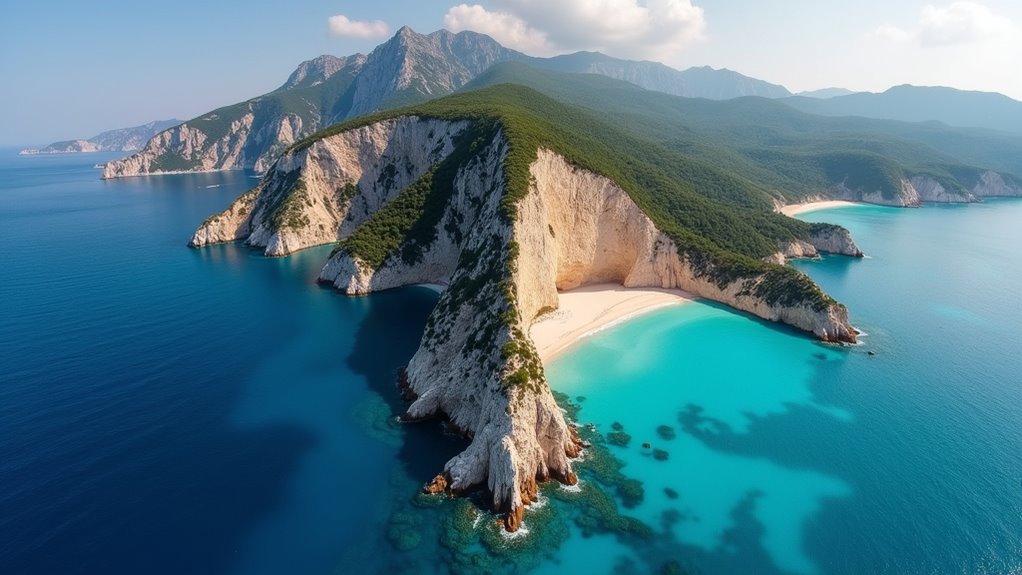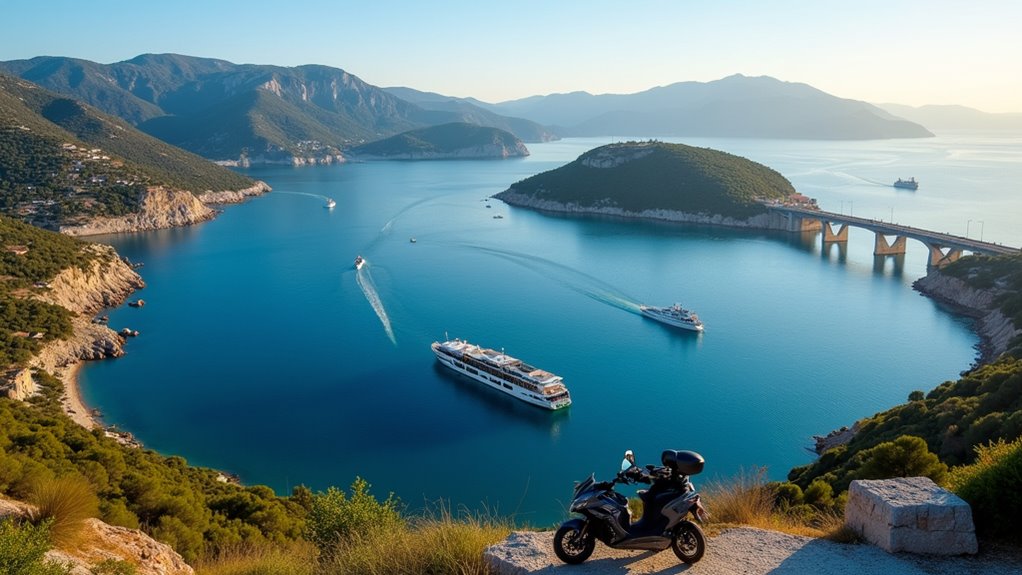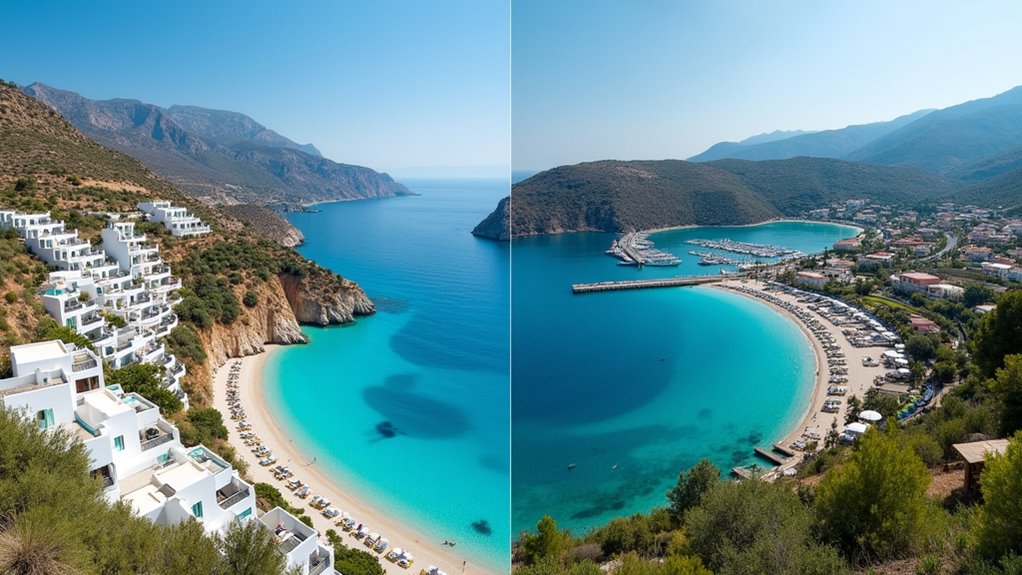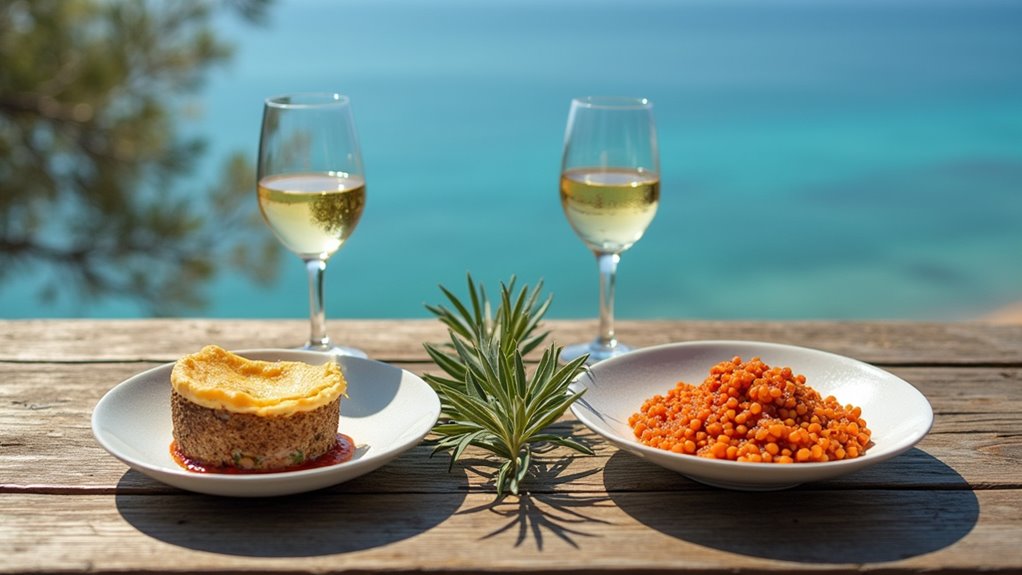Physical Address
304 North Cardinal St.
Dorchester Center, MA 02124
Physical Address
304 North Cardinal St.
Dorchester Center, MA 02124

Discover which Ionian gem suits your island dreams as Kefalonia and Lefkada compete for your vacation heart.
Like Helen of Troy, both Kefalonia and Lefkada have launched a thousand ships with their enchanting beauty—but which deserves your vacation allegiance? You’re facing a delightful dilemma that many travelers to Greece’s Ionian Sea encounter. Whether you’re drawn to Kefalonia’s diverse landscapes and hidden coves or Lefkada’s world-class windsurfing and dramatic cliffs, your perfect Greek island awaits. The answer lies not in which island is objectively better, but which one aligns with your travel style and priorities.

While both islands belong to the mesmerizing Ionian archipelago, Kefalonia and Lefkada present distinct geographical profiles that shape your island experience.
The Ionian siblings offer uniquely different island personas, each crafting your Greek adventure through its distinctive geographical character.
Kefalonia, positioned in the southern Ionian region, is notably larger with a varied coastline of dramatic bays. Its mountainous terrain features Mount Ainos with unique black fir forests that you won’t find elsewhere. The island is renowned for its natural wonders like the impressive Myrtos Beach that attracts visitors from around the world.
In contrast, Lefkada sits more centrally in the archipelago and offers the remarkable advantage of mainland connection via bridge, making it considerably more accessible if you’re driving. Unlike Corfu with its popular beach clubs, Lefkada maintains a more serene atmosphere for those seeking tranquility.
Though smaller, about 60% of Lefkada remains mountainous, preserving its natural beauty. You’ll also find a distinctive lagoon near Amvrakikos Bay—an important ecological zone.
Both islands enjoy the calmer waters of the Ionian Sea, perfect for sailing and water activities.
The geographical differences between these two Ionian gems naturally lead to their most celebrated features—the beaches and natural wonders that draw travelers from across the globe.
Lefkada dazzles with Porto Katsiki and Egremni‘s dramatic cliff-backed turquoise waters, offering spectacular sunset views on the west coast. You’ll find mostly pebble beaches with intensely azure waters, though summer brings crowds. Lefkada is 100% worth visiting for travelers seeking dramatic coastal scenery and crystal-clear waters.
Kefalonia counters with greater variety—Myrtos Beach’s sandy shores beneath limestone cliffs, Xi Beach’s therapeutic rust-colored sand, and pine-fringed Skala Beach with full amenities. Frequent visitors often describe Kefalonia as having better beaches overall, particularly for those who prefer sandy shorelines.
Beyond beaches, explore Lefkada’s Dimosari Gorge and Nydri Waterfalls, or Kefalonia’s mesmerizing Melissani Cave with its sunlight-illuminated underground lake and Mount Ainos National Park‘s rare black fir forests.

Considering your vacation logistics can dramatically impact your Ionian island experience, with Kefalonia and Lefkada offering distinctly different transportation challenges and advantages.
The transportation puzzle you solve before arrival shapes every moment of your Ionian island adventure.
Kefalonia boasts better air connectivity with more frequent international flights, though you’ll need ferries for further travel. While flight savings might seem attractive, factor in costly taxi transfers (€200 to Fiskardo) or navigate the local bus system. If you’re torn between destinations, remember that unlike must-visit destinations like Santorini, these islands offer more authentic Greek experiences with fewer crowds.
Lefkada’s unique advantage is mainland road access via bridge, eliminating the ferry dependency that defines Kefalonian travel. Preveza Airport sits just 20km away with €40 taxi transfers, though it offers fewer flight options.
For island-hopping, direct ferries connect Fiskardo to Vasilikí in about an hour, while budget travelers might prefer the scenic €8.50 route to Nidri. The journey between these two islands spans approximately 89 km and requires careful planning for seamless transit. Always book car ferries ahead during peak season.
Both Kefalonia and Lefkada offer opulent cultural tapestries woven through centuries of diverse influences, though each island presents this heritage in distinctly different ways.
In Kefalonia, you’ll discover the stunning Drogarati Cave and Melissani Lake alongside an Archaeological Museum housing Mycenaean to Roman artifacts. While many travelers to Greece focus on visiting ancient landmarks in Athens, Kefalonia offers a different but equally enriching historical experience. Despite the devastating 1953 earthquake, charming Assos village retains its pastel-colored houses and Venetian fort.
Lefkada boasts the impressive 14th-century Agia Mavra Castle and Cape Lefkatas, famously linked to Sappho’s tragic leap. The island’s literary legacy shines through native poets Valaoritis and Sikelianos, celebrated at the annual Speech & Art Festival. Lefkada’s physical connection to mainland Greece via a connecting bridge offers easier access compared to other Ionian islands.
You’ll also notice Lefkada’s distinctive wooden houses with colorful metal roofs—architectural adaptations to frequent seismic activity.

When planning your Ionian getaway, understanding the tourist infrastructure and accommodation options on each island will substantially impact your experience.
Kefalonia offers more developed amenities with its international airport, better-maintained highways, and accommodation ranging from hostels to luxury resorts. You’ll find 24/7 supermarkets and a central hospital in Argostoli, making it ideal for longer stays and families. As the largest island in the Ionian Sea, Kefalonia provides more space and scenic variety for travelers to explore.
Lefkada, accessible by bridge from mainland Greece, eliminates ferry dependency but has no airport. Accommodation here leans toward family-run guesthouses and vacation rentals. Families visiting the Ionian islands might consider Kefalonia for its family-friendly resorts that offer dedicated children’s activities and amenities. Its mountainous roads are narrower, and medical facilities are limited to clinics for minor emergencies.
Both islands require advance booking (3-6 months) during peak season, and you’ll need a rental car to explore effectively. Kefalonia commands higher prices, while Lefkada offers better value for mid-range budgets.
The azure waters surrounding the Ionian Islands beckon adventure-seekers with countless opportunities to play, explore, and challenge themselves.
Crystalline seas of the Ionians invite thrill-seekers to discover their natural playground.
Kefalonia excels in underwater adventures, offering exceptional scuba diving and snorkeling around coastal rock formations. Don’t miss the magical Melissani Cave with its underground lake or the hiking trails in Mount Ainos National Park with its endemic fir species. Both islands provide wonderful family-friendly activities that can create lasting memories for travelers of all ages.
Lefkada is the clear winner for wind-based sports with:
Active travelers can also enjoy canyoning expeditions through Lefkada’s dramatic Dimosari Canyon, combining hiking, climbing, and swimming elements.
If you’re into cliff diving, Lefkada’s Porto Katsiki and Cape Lefkatas provide thrilling spots, while Kefalonia offers gentler coastal trekking and birdwatching experiences.

Food lovers exploring the Ionian Islands will discover that dining goes far beyond mere sustenance—it’s a cultural journey through generations of island tradition.
In Kefalonia, you’ll savor signature Kreatopita (spiced meat pie) and octopus pie baked with local herbs. Their dishes often feature distinctive wine-infused sauces with bay leaf and cinnamon, particularly in clay-pot “Tserepa” chicken preparations.
Lefkada’s culinary identity centers around Bourdeto (spicy fish stew) and Pastitsada (meat with tomato-pasta). Their slow-cooking techniques incorporate red pepper marination, with tomatoes and pasta forming the backbone of most traditional recipes. Lefkada is also known for its delicious Ladopita, a traditional dessert made with olive oil and semolina topped with sesame seeds and almonds.
Both islands offer remarkable dining ambiance—Kefalonia with rustic tavernas showcasing earthquake-resistant architecture, and Lefkada with family-run seaside eateries in Venetian-influenced villages.
Wherever you dine, high-quality olive oil underpins the extraordinary flavors.
Choosing between Kefalonia and Lefkada often comes down to matching your travel personality with the island that best complements it. Kefalonia appeals to nature enthusiasts and history buffs seeking authentic Greek experiences without overwhelming crowds. You’ll find diverse landscapes from Mount Ainos’ rare fir forests to Melissani’s underground lake, along with abundant cultural heritage in traditional villages like Assos. For travelers seeking Mediterranean allure without venturing too far, Kos island’s charm offers a compelling alternative in the Dodecanese.
Lefkada, meanwhile, is perfect for:
Photographers and landscape lovers will appreciate Lefkada’s dramatic scenery featuring steep limestone cliffs along the western coastline that create stunning vistas.
If you’re after luxury and relaxation, Kefalonia’s high-end resorts and private yacht charters in Argostoli might be your ideal match, while family travelers appreciate its protected swimming areas.
Whether you fall for Kefalonia’s untamed beauty or Lefkada’s windswept shores, you can’t go wrong. Kefalonia welcomes you with open arms and hidden gems waiting to be discovered, while Lefkada calls to your adventurous spirit like a siren song. They’re both stars in the Ionian crown—just pick the one that matches your vacation rhythm. The right choice isn’t about which island is better, but which one feels like home to you.